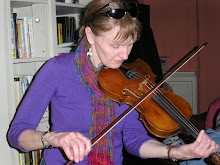The final day of the tour takes us from Inverness via Stirling, back to Glasgow where we started. 2013 will stand out as the tour we traveled on the most B roads, the latest arrival of spring, the most prompt group of travelers to date, and a plethora of newborn lambs, After 6 tours, give me a week to regroup, and I'm looking forward to next year. Join me April 29-May 12, 2014!
.jpg) |
| Scotland is a cheese lover's paradise. We stopped at the House of Bruar food hall to purchase picnic food. |
.jpg) |
| Rudy has been weaving on the Unicorn tapestry project at Stirling Castle for 7 years |
.jpg) |
| A section of the last tapestry being woven at the castle. |
.jpg) |
| When we visited the castle in 2012, this piece had been been started Oct 2011. See the ink around on the warps with cartoon in the background. This is the same section as the now woven piece above. |
.jpg) |
The color print out from the final piece being woven . Only fragments of the 7th original tapestry remained at the Cloisters Museum in New York. Historic Scotland wanted an entire piece, so the tapestry titled "Sight" from the
Cluny Museum's set of Unicorn tapestries was used for this design. |
.jpg) |
| The weaving studio was built at Stirling Castle for the 13 year long project. Some of the tapestries were woven at West Dean Tapestry Studio in England. |
.jpg) |
| Sharolene with the animated castle guide |
.jpg) |
| "The Start of the Hunt" now hangs with the other completed tapestries in King James V Royal Palace at Stirling. The tapestries were woven for the refurbishing of the palace. There are records King James V had many tapestries in the palace. However, none remain. The original Unicorn tapestries are from the same time frame, earyly 1500's , so were chosen as the set to reproduce. |
 |
| One of the oak Stirling Heads in the Royal Palace. Tapestries were not the only things recreated for the palace restoration. All 56 heads were carved anew based on 38 originals and drawings. |
 |
Sad goodbyes were said by all to our wonderful driver/guide Karen from Rabbies Trailburners. Just a few days after our trip Karen and coach mascot, Callie, were back on the road taking a group of photographers on a wee wander around the country.
|
All photography and text by Nadine Sanders.
.jpg)
.jpg)
.jpg)
.jpg)
.jpg)
.jpg)

.jpg)
.jpg)





.jpg)




.jpg)
.jpg)
.jpg)
.jpg)
.jpg)
.jpg)
.jpg)
.jpg)
.jpg)
.jpg)
.jpg)
.jpg)
.jpg)
.jpg)
.jpg)
.jpg)
.jpg)
.jpg)
.jpg)
.jpg)
.jpg)
.jpg)
.jpg)
.jpg)
.jpg)

.jpg)









